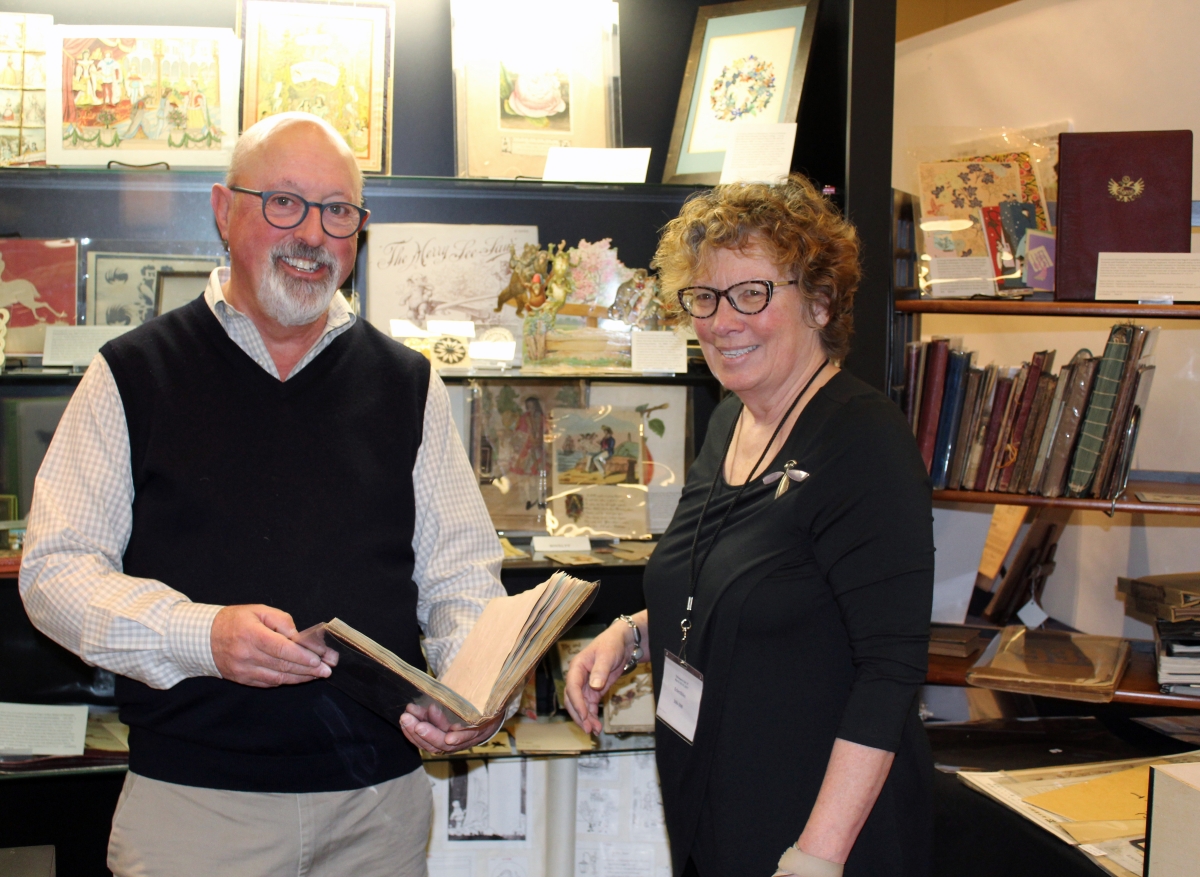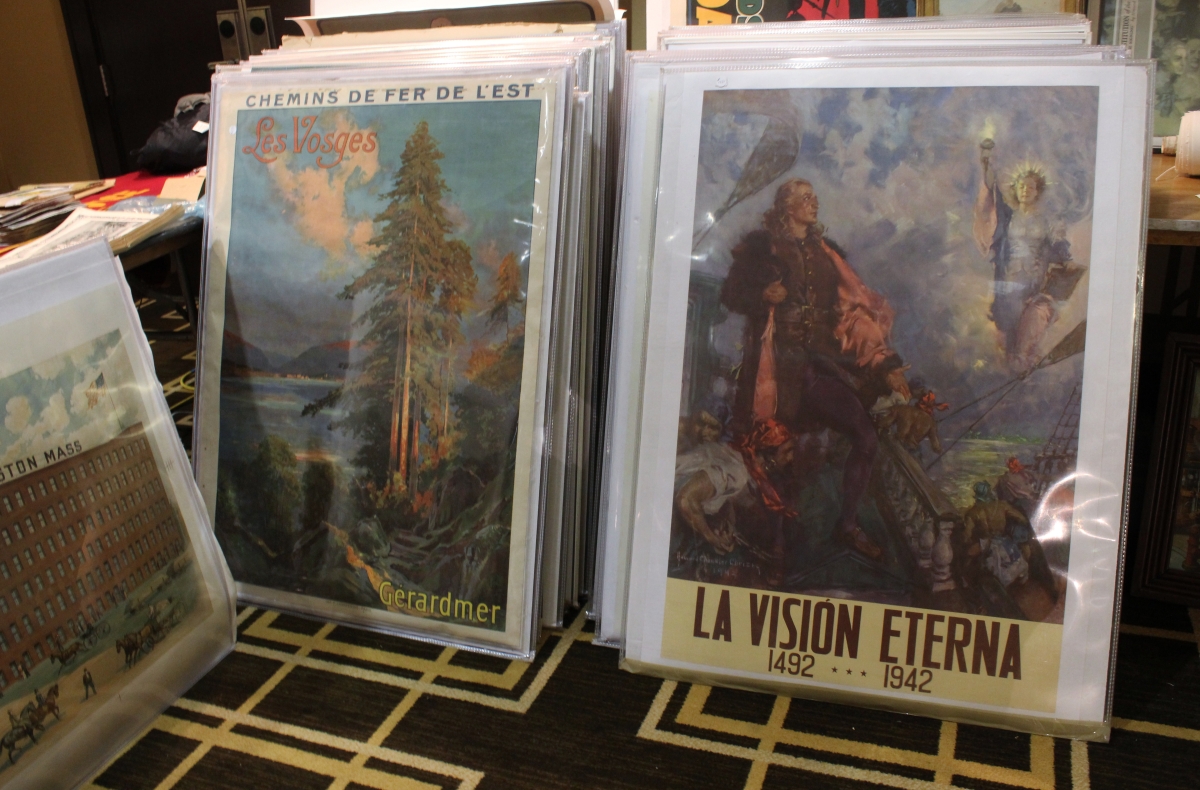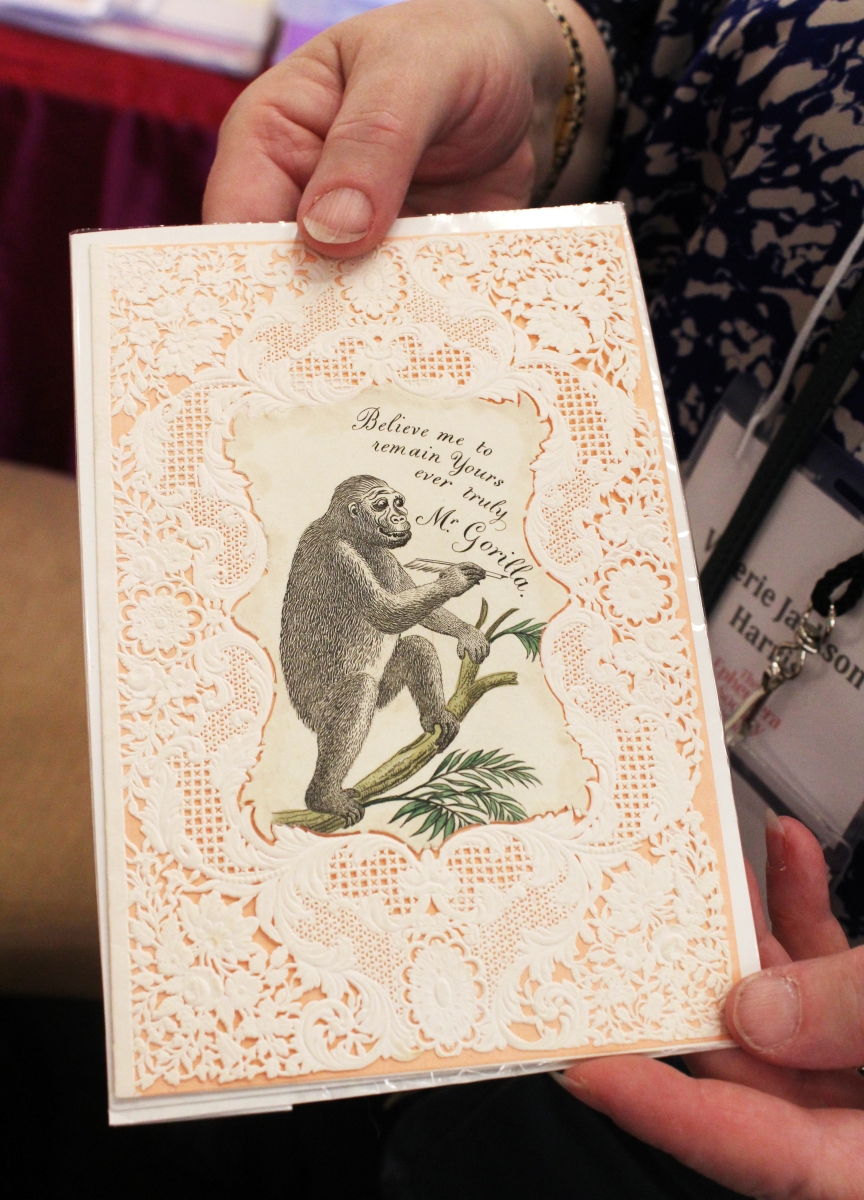
The usual posture at ephemera shows is head-down, and that is the case with these shoppers browsing the burgeoning booth of Peter Luke, New Baltimore, N.Y., although the person in the middle may be doing some electronic multitasking.
Review and Photos by W.A. Demers
OLD GREENWICH, CONN. – For two days, Old Greenwich is the “Ephemera Capital of the World,” a paper chaser’s dream, as more than 75 dealers fill the ballroom and adjoining corridors of the Hyatt Regency Hotel with more than 10,000 antique paper items. This year’s show, Ephmera37, sponsored by the Ephemera Society of America, March 18-19, was the second one under the management of Marvin Getman of Impact Events Group, and it received consistently high marks from dealers and shoppers alike. “It is a showcase for the world of paper,” said Arrowsic, Maine, dealer James Arsenault, who has exhibited here for about 20 years, “certainly the ‘cream of the crop.'”

Show promoter Marvin Getman and Sheryl Jaeger of Eclectibles confer before the show opens. In addition to managing her Eclectibles business, based in Tolland, Conn., and specializing in Nineteenth and early Twentieth Century ephemera, Jaeger is on the Ephemera Society of America’s board of directors.
The show comes in its own wrapper – a four-day fair, exhibition and conference, whose theme for its 37th edition was “American Ingenuity: What’s the Big Idea?” In addition to the two-day show that is open to the public, the larger event managed by the Ephemera Society of America features the organization’s annual convention with speakers and presentations examining the use of ephemera that documents innovation in everything as varied as air travel, communications, medicine and photography.
One of the premier dealers at the intersection of science and ephemera is Topsfield, Mass., dealer John Kuenzig. An early photograph of American inventor Thomas Edison in his chemistry lab was notable in Kuenzig’s booth, especially due to the fact that it was marked up for either magazine or advertising reproduction with many annotations in the margins and crop marks made to emphasize the man rather than the busy background of test tube racks. The photograph sold to a collector, according to Kuenzig, as did an unusually large photograph of an early Cleveland bicycle racer and bike, circa 1899, that was taken by the same photographer known for capturing the likeness of collectible baseball cards king Honus Wagner.
An additional scientific highlight in Kuenzig’s booth was a pair of albumen photo-micrographs mounted in 14-by-16-inch Victorian-era walnut frames of blood disks by Samuel William Fletcher, Pepperell, Mass., circa 1870. These are images of microscopic objects that are printed in a size which is visible to the naked eye without the use of magnification. A practicing doctor for most of his life, Fletcher was also an inventor, having designed a type of microtome, an example of which is in the collection of historical scientific instruments at Harvard University.
“We sold inexpensive items as well – cigar labels, old trade cards, pamphlets, swatch books, diaries, etc,” said Kuenzig. “Shows are one of the best places for new collectors to get their feet wet, and even at a ‘high-end’ show like this there were bargains to be had, and much for the curious to see.”
Kuenzig added that he was happy with the fair after being away for some years. “We had good sales – institutional, retail and dealer. The show was run very well by Marvin Getman and the hotel comfortable and well appointed. The crowd of buyers were, as always, sophisticated and knew what they were looking at – a pleasure for us, as we often learn about our offerings as well. And the conference presentations were well crafted and interesting.”

Collector Michael Russo said he inherited the ephemera collecting gene from his late father Angelo M. “Russ” Russo, who lived in Milford, Conn., and collected holiday ephemera, especially Christmas, valentines and Halloween. Here Michael examines what is referred to as a “boxed valentine,” a multilayered confection popular in the 1870s, at the booth of Cardtique, Stillwater, Minn.
Sheryl Jaeger, who is both an exhibiting dealer and a member of the society’s board of directors, has insight into the conference sessions. “Overall, the event was a great success,” she said. The conference “American Ingenuity: What’s the Big Idea?” featured learned and passionate collectors and curators delving into topics such as aviation, quackery, photography, innovation in play, World’s Fairs and more – all enhanced with the more than 700 images of ephemera that helped tell their stories.”
Jaeger offered that there had been some concern given the change in the spring fair schedule with the New York Book Fair the week before Ephemera/37. “Concerns were allayed,” said Jaeger. “The fair was well attended and the word from most was ‘spirited buying and/or selling.'”
From the perspective of Jaeger’s business, Tolland, Conn.-based Eclectibles, “selling was brisk through Sunday afternoon,” she said. “We sold a fine 1927 photo travelog featuring employees of Barnum and Bailey Circus, numerous Victorian transformation pieces, manuscript materials, lots of ephemera relating to social history and more at various price points.”
Out for the first time in a show was a rare survivor – a patent medicine poster printed by Dutton & Wentworth, circa 1850s. It was mounted on linen, observed dealer James Arsenault, which he said probably contributed to its remarkable state of preservation. Utilizing almost every conceivable type font and three-color printing, the poster was a compendium of quackery that passed as science in the times, boldly proclaiming “Indian Vegetable Medicines!” prepared by Dr J.S. Spear, “The Old Indian Doctor,” with patent remedies for pain killers, hair restorers, scrofula syrup, fever drops, salves and “The Woman’s Friend – Mother’s Cordial,” among other cures.
The real eye-catcher in the dealer’s booth, however, was a larger-than-life-size Lady Liberty, very likely a one-off, according to Arsenault, probably produced by Chicago-based Kurz & Allison for the 1893 World’s Columbian Exposition.

Bill Subjack of Neverbird Antiques holds up one of the many sampler highlights, this one wrought by Agnes Mary Smith in 1837 referencing the end of slavery in the British West Indian colonies in 1834.
A number of dealers made a cross-country trek to exhibit at the fair. From Seattle, Michael Fairley of Fairlook Antiques and Michael Maslan were sharing booth space. Fairley specializes in graphic ephemera, such as the lively, large-format cartoon art that was produced for display in America’s churches and religious households in the early Twentieth Century by artists such as E.J. Pace. Maslan concentrates on vintage posters, photo postcards and photographs, including for this time out a circa 1905 image of a Native American group including Geronimo, chief of the Apache tribe.
Said Fairley, “The show was well attended with knowledgeable people coming in. Additionally, there were a number of local first-time attendees who responded to new local advertising. This helps to broaden the future buying base. Interestingly, my biggest sales were early, rare and unusual real photo postcards in a variety of subject areas.”
Described as an “evolutionary chess set” pitting mammals versus reptiles, a hand carved and painted set was apparently inspired by the discovery of the chemical structure of DNA in 1953, according to Bill and Joyce Subjack of Neverbird Antiques, exhibiting at this show for the first time. “It’s a great example of home school folk art,” said Bill. “It’s undated, but was likely created 1960-1980.” The dealers are known primarily for their Eighteenth and early Nineteenth Century needlework and folk art, historical books and documents and smalls, and they brought some of this material to this show. One highlight was a sampler wrought by Agnes Mary Smith in 1837 referencing the end of slavery in the British West Indian colonies in 1834. Another was a rare example wrought by a member of a missionary school in Hawaii dated 1841 and utilizing only the 12 letters that are in the Hawaiian alphabet, according to Bill.
An international sensibility was represented by Valerie Jackson-Harris, whose London-based business Quadrille presents, in her words, “anything I’ve never seen before.” In business for more than 50 years, Jackson-Harris is also the current chairman of the UK’s Ephemera Society, quickly pointing out that the organization is simply the Ephemera Society, because it came long before the Ephemera Society of America and others. Highlights in her booth included a 1655 letter from William Burgess to Sir Robert Long informing him that the household was going to Windsor “to get away from the plague” and a rather grisly broadside portraying a public hanging and recounting the crimes and executions of two men and a woman convicted of murders in 1834.
Sharing an adjoining space with Quadrille was Barbara Loe, a Stillwater, Minn., dealer with a specialty in Victorian valentines and trade cards. Collector and vice president of the National Valentine Collectors Association Michael Russo was at her showcase examining a multilayered “boxed valentine,” examples of which were popular in the 1870s. He did not purchase that item, but did add to his collection what he described as “an amazing mirror valentine circa 1845, one nearly identical to a piece featured in Frank Staff’s book The Valentine & Its Origin.” It is now the largest example of the form in his collection, proving, he said, that “you can always find a treasure or incredible addition for your collection at this show. I look forward to attending this show all year and after it closes, I start thinking about the next one.”
For additional information, www.bookandpaperfairs.com, www.ephemerasociety.org or 781-862-4039.

















